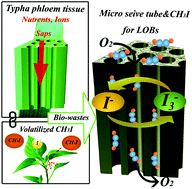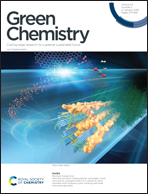Micro versus nanochannels: carbon micro-sieve tubes from biological phloem tissues for lithium–oxygen batteries†
Abstract
The transport of photosynthetic products and salts occurs continuously in the phloem tissues of the vascular hydrophyte, Typha. Multiphase transport of oxygen, electrons, and ions also plays an essential role in lithium–oxygen battery (LOB) cathodes. The similarity in transport behavior is the inspiration for the development of advanced cathode design from natural phloem tissues. Using a top-down process, the special tissues are converted into micron-scale sieve tubes. The designed structure has a high ratio of the tube diameter to the size of the discharged product (6 : 1), which ensures the uniform coverage of Li2O2 on micro-channel surfaces avoiding pore-clogging on typical nanoscale carbons, and exhibits a high specific capacity of 9100 mA h g−1. Besides, the biologically enhanced structure also plays a pivotal role in the extraordinary cycling stability of 270 cycles with a cutoff capacity of 1000 mA h g−1 due to the robust structure and thick tube walls. In addition, iodomethane, a bio-waste volatilized from plants, is utilized as an electrolyte additive and improves the round-trip efficiency to 86%. The integration of phloem tissue carbon and iodomethane paves the way for the ready conversion of abundant biomass into high-value engineering products for energy-related applications.



 Please wait while we load your content...
Please wait while we load your content...